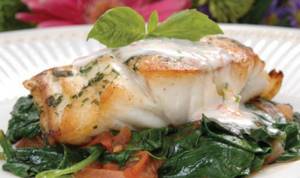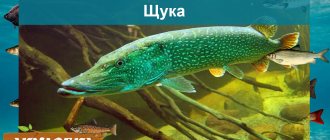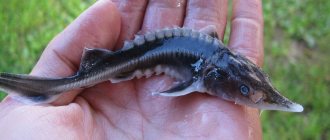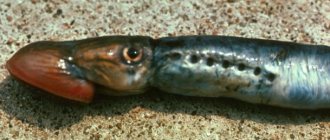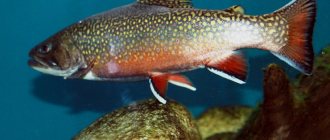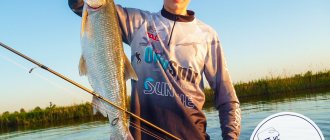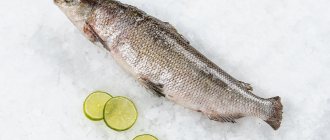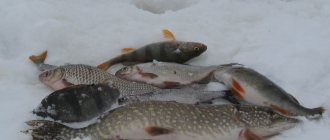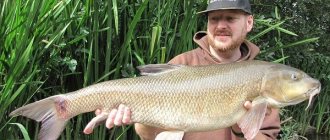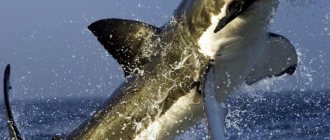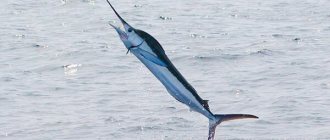- Wild animals
- >>
- Fish
Grouper fish is one of the most interesting and unusual marine inhabitants. Today, scientists count about a hundred species of grouper. Some of them are real giants, weighing half a ton and up to three meters long. There are also species whose body size does not exceed several tens of centimeters. Different representatives of the species have not only different sizes, but also appearance and lifestyle. This fish is highly valued among gourmets due to its unusual, delicate taste and special aroma. In addition, its meat is practically devoid of calories and enriched with vitamins and minerals. The fish is found under the name mirow or black.
Origin of the species and description
Photo: Grouper
Grouper is classified into the phylum Chordata, class ray-finned fish, order Perciformes, family rock perch, genus grouper.
The lifestyle, features of vital activity and stages of evolution of the rock perch have not been thoroughly studied. However, scientists and researchers have determined that these representatives of marine flora and fauna appeared about five million years ago. The appearance of the Isthmus of Panama about 3 million years ago contributed to the division of fish into two subspecies due to the division of the population territorially.
Video: Grouper
In the process of adapting to new conditions of existence and in the process of evolution, the grouper has learned to change its body shape and color in order to camouflage itself and remain unnoticed in the event of approaching danger. Also, in the process of evolution, the shape and structure of teeth have changed somewhat. They are arranged in several rows and are somewhat reduced in comparison with the original size.
Scientists note that grouper is one of those representatives of marine flora and fauna that have practically not changed since their appearance. In the process of distribution, fish were divided into many subspecies, each of which acquired distinctive external characteristics, characteristic features of behavior and lifestyle.
Grouper species
The largest representative of the genus is the giant grouper. It is brownish with beige spots on a dark background. The saturation of the background and the severity of light spots depend on the age of the individual. Over the years, the color darkens. The fins of fish up to 20 centimeters in length, for example, are yellow, while those of meter-long perches are already brown.
The second name of the giant species is small-eyed Indian Ocean. However, from the Indian Ocean the species spread to the Pacific and Atlantic. Several years ago, scientists concluded that different subspecies of the giant type live in the Atlantic and calm waters. Previously they were considered one species. Scientists considered the Isthmus of Panama to be the cause of the minor changes.
It began to form 2.5 million years ago. Having divided the once united ocean, the Isthmus influenced the climate on both sides. The fish that remained in certain waters had to adapt to new conditions.
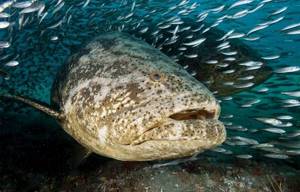
There is information that a giant grouper can eat a shark
It is with giant groupers that the facts of eating sharks and attempts on people are associated. The last cases are exceptional. Usually, rock perches only accompany divers without attacking. Pisces show curiosity, but not aggression.
Due to its size, the Indian Ocean species remains outside the aquarium hobby. The red grouper is selected for her . Named after the color. He is orange-scarlet. Turquoise “peas” are located on the main background.
As with giants, reds are lighter when young and darker when older. Spectacular fish are easy to keep. Even beginner aquarists take rock perches. The length of the red grouper reaches 40-45 centimeters.
The only problem in keeping them is aggression towards individuals of their own species. When taking several scarlet perch, you need to provide them with space and plenty of shelter. Without sharing living space, the heroes of the article are ready to tolerate each other.
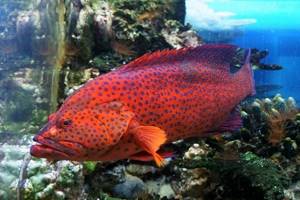
Spotted perches are also taken into aquariums. They are also spotted, but the markings are hexagonal, like a honeycomb. The print is brown and the overall background is slightly reddish. There are 2 large whitish spots with jagged edges on the back. Sometimes there are light marks on the animal’s abdomen. The spots are smaller here. The spotted grouper is 3-15 centimeters larger than the red one.
It is more difficult to fit senderong into the aquarium. This species is striped. If not for the yellow fins, the color would resemble that of zebras. Almost black stripes alternate with white ones. The alternating lines stretch 1.5 meters. This is the length of the senderong. Accordingly, the minimum volume of the aquarium per individual is 3000 liters.
Senderong is more elongated than most perches, flattened on the sides. This does not prevent the animal from eating 2 times more than other groupers of equal size. The gluttony of representatives of the species is an additional difficulty in keeping them at home.
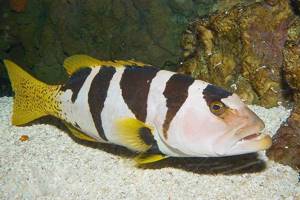
Pictured is a senderong perch
Potato grouper also swims in the ocean waters . The color of the animal is similar to the root crop. Otherwise, perch bears little resemblance to potatoes. The fish reaches one and a half meters in length and can weigh up to 110 kilograms. This size prevents the animal from being eaten as food. The meat of large potato specimens is tough and tasteless.
The main commercial species among rock perches is coral perch. The fish lives in corals and resembles them in color. Polyps at the bottom, of course, are blue, white, even black. But, most corals are red. So is the coral snapper. Among its family, the animal is medium in size. Individuals weighing 15-20 kilograms are considered trophy. This mass is typical for fish about a meter long.
The name greasy perch evokes an appetite. It lives up to its name, delighting lovers of oily fish. The integument of the animal also resembles lard. The scales are colored like smoked bacon. In the Red Sea, greasy perches weighing 250 kilos were caught.
You can thoroughly stock up on both lard and meat. We'll tell you how to do this in the next chapter. At the same time, we will get acquainted with several more species of groupers. You can’t describe all 100, but the main ones are worth counting.
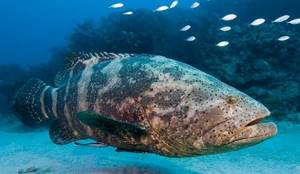
The potato grouper was named for its similarity to the color of a potato tuber.
Appearance and features
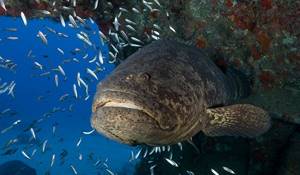
Photo: Grouper fish
Regardless of the subspecies, size and region of habitat, all groupers are characterized by certain features that unite them.
Characteristics of groupers:
- large, massive body, somewhat flattened laterally;
- gill covers with spines;
- huge oral cavity;
- the presence of one spiny fin on the surface of the back;
- the presence of three spines on the anal fin;
- the teeth are short and very sharp, arranged in several rows.
This type of perch is called stone perch because of its external similarity to bottom boulders. This is not even explained by the huge size of the body, but by the specific coloring, which is very similar to rocks, stones and coral reefs. There are many dots, circles, stripes, etc. on the body of fish.
Fish also has a number of specific characteristics that distinguish it from other representatives of marine flora and fauna.
Features:
- small, round eyes;
- a huge, wide head part, against which the eyes seem especially small and insignificant;
- Almost all grouper individuals are hermaphrodites. They have an ovary to produce eggs and a testis to produce the cells that fertilize them;
- Body sizes can reach from 10 centimeters to three meters.
Interesting fact: Fish are endowed with the ability to change color and body shape for the purpose of camouflage.
The body weight of one adult individual depends on its size and ranges from 10-20 to 350-400 kilograms. The color can be very diverse, from bright, rich red to mottled, gray or brown. It depends on the region where the predator lives. The oral cavity is very large, slightly pushed forward. It is framed by skin growths that give the shape of pronounced lips.
Description and features of fish
Groupers live under the water column among rocks. In such an environment, the fish are camouflaged. The coloring of the bodies resembles corals, granite blocks, and rocks.
This is a predator, which explains the structure of the individual. The jaw is massive, moves forward strongly, resembling the shape of a tube when the creature opens its mouth. This biological structure helps absorb prey from the water column.
Since the fish of this family have large jaws, the main diet of the predator is sharks, small lobsters, stingrays, and baby sea turtles.
The body length can be from 3 cm to 3 m. For example, the largest is the Atlantic giant grouper. The eyes of fish are small and round. They are not proportionate to the size of the head, which is massive and wide.
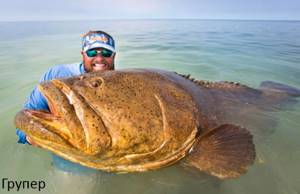
Where does the grouper live?
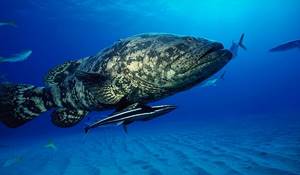
Photo: Giant grouper
The vast majority of grouper species live in marine waters. All of them are heat-loving fish and choose tropical or subtropical waters. Only two of all described species are found in Russia.
Geographical regions of grouper habitat:
- South African Coast Bay;
- Red sea;
- Algoa;
- Greenland;
- coast of Panama City;
- Pacific Ocean;
- Indian Ocean;
- Atlantic Ocean;
- Southern coast of Japan;
- coast of America;
- coast of the Hawaiian Islands.
The fish can live at various depths from 15 to 50 meters. A prerequisite for the habitat of groupers is the relief of the bottom, which is necessary to provide shelter. These can be sea stones, boulders, thickets of coral reefs, sunken ships, deep caves, rocks, etc. Fish from regions with sandy and excessively muddy bottoms do not tolerate it.
Fish of this species are not characterized by a tendency to migrate. They spend most of their lives in a certain territory. In addition, they are very passionate about its protection of its habitat. They can easily and without hesitation engage in fights with opponents whose body size and strength can significantly exceed their own dimensions. A person can also be in danger if he gets too close to a predator’s hideout. A predator with lightning speed, with an open mouth, attacks from its shelter an object that poses a danger to it. Particularly large individuals can even swallow a person.
Now you know where grouper fish are found. Let's find out what we eat.
Useful properties of grouper
Meat contains a lot of protein in an easily digestible form, micro- and macroelements that are beneficial to human health.
Groupers are an excellent food because these fish are famous for their valuable characteristics:
- high protein content, so the product is considered dietary;
- the presence of selenium, potassium, phosphorus, sodium and calcium;
- essential acids in sea fish fillets, which help speed up metabolism in the body and enrich every cell with oxygen;
- high content of vitamins, which help improve the functioning of nerve cells and help keep sugar at the right level.
The beneficial properties of this fish fillet are not limited to those listed. With regular consumption, a person's skin condition improves. At the same time, people manage to cope with problems with the thyroid gland.
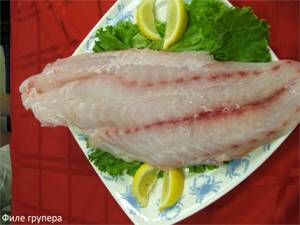
The product can be used once a week. This will help reduce the concentration of cholesterol in the body, improve the walls of blood vessels, and strengthen the tissues of the nervous system. In old age, people who systematically consume dishes from this fish do not have memory problems.
Culinary characteristics
Due to its taste characteristics, the product is popular among residents of Europe and America. People love to eat individuals weighing 30−50 kg. The fillet has almost no bones, and after cooking it has a delicate and pleasant taste.
Groupers up to 50 kg are considered delicacy. Many chefs around the world consider it an honor to cook such a large fish according to their own recipes. The cost of dishes made from such a product is high. And adult, too large representatives are considered inedible.
Small fish weighing up to 1 kg can be cooked over an open fire immediately after being caught at sea.
The food is served with rice or pasta and decorated with cheese, herbs and nuts. They can cook shish kebab from this fish. Since it is hearty, you can serve it with fresh vegetables without any other side dish.
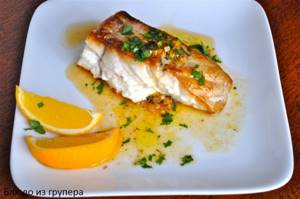
What does grouper eat?
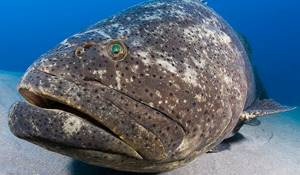
Photo: Atlantic grouper
Rock perch is a predatory fish. He is absolutely not picky about food and eats everything he can swallow. The main condition is that the prey must fit into the predator’s mouth. The grouper is a real hunter. He can wait for his prey for a long time, being in cover. When the prey is as close as possible, the predator simply attacks it with its mouth open.
If the prey turns out to be agile and fast, and the rock perch fails to catch it, it easily starts a long chase. A case is described when a huge representative of this species swallowed whole a one and a half meter shark, which fell off a fisherman’s hook. The predator chased the shark for quite a long time, and when it broke away, it instantly swallowed it. With its mouth wide open, the rock bass has a truly intimidating appearance. Therefore, individuals that are large in size pose a serious danger. Divers are advised not to get too close to them.
The grouper has one unique ability - it can hunt in alliance with a moray eel. When a predator feels that its prey is out of reach, it calls its companion for help. To do this, a huge predator approaches the moray eel’s shelter and shakes its head from side to side several times. Most often, the moray eel responds and a joint hunt begins. The moray swims into the shelter where the victim is hiding and drives it out of there. In some cases, the stone perch's partner does not mind feeding herself.
In most cases, grouper prefers to hunt on its own and not share with anyone. Rock perch have their own taste preferences.
What does grouper eat:
- lobsters;
- crabs;
- shellfish;
- stingrays;
- small sea turtles.
Grouper nutrition
Not many people want to see up close what a grouper fish looks like with its mouth open. It opens so wide that large individuals are able to suck directly into the human esophagus. This could have happened in 2016 in African waters. A grouper attacked a diver. He managed to grab onto the gills of the fish and climb out through the impressive cracks in them.
Being predators, groupers overtake their prey. When hunters open their mouths, a pressure difference occurs. The prey is literally sucked inside the grouper. He often hunts alone.
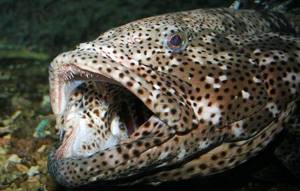
If the prey escapes, the fish may call the moray eel for help. Swimming up to its shelter, the grouper quickly shakes its head 5-7 times. According to video footage, 58% of moray eels accept the request, emerging from cover even during the day, even though they are active at night.
Together the predators swim to the prey's hiding place. E searches for grouper, signaling the presence of prey to the moray eel. She gets into the shelter. In half the cases, the assistant swallows the prey herself. In other situations, the moray eel only drives the fish out of cover directly into the grouper’s mouth.
The union of groupers and moray eels is due to the following:
- The grouper easily tracks prey, but due to its heavy body it cannot penetrate into the shelter.
- Moray eel is lazy in searching for prey, but its snake-like body easily slips into the “holes” of tasty morsels.
Groupers also hunt with pelicans. The fish are waiting for the flock of birds to enclose the school in their ring. Then the solitary grouper hunters take the stray individuals for themselves. In an alliance with moray eels, competition and clashes might, however, not be recorded.

This is rare in the natural world. Moray eels readily give up half of the fish they track, just as groupers are not against eating the other half by an ally.
When hunting with pelicans, groupers do not claim their prey, only those who have escaped from the flock in panic.
The favorite food of groupers is lobsters. My second favorite dish is crabs. In addition to them, groupers catch shellfish and most fish, including sharks and rays. Sometimes young sea turtles become victims.
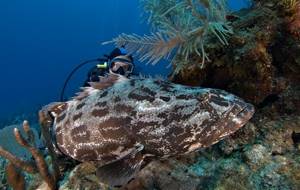
Features of character and lifestyle
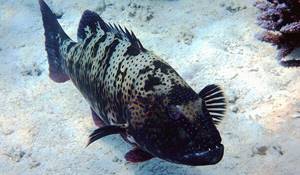
Photo: Grouper fish
Grouper is characterized by territoriality. They live in the same territory almost throughout their lives, and they do not tolerate the appearance of rivals or other inhabitants on it. They see rivals not only in humans or representatives of other species of marine flora and fauna, but also in their relatives. When the slightest danger appears, the predator swims out of its hiding place with its mouth open. In doing so, it can cause serious injury. The attacks can continue repeatedly. In the process of defending their territory, predators can fight with rivals that are several times larger than them in size and power.
Groupers tend to spend most of their time in cover. As such, predators most often choose coral reefs and sunken ships. Fish can leave their chosen shelter only when they need to give chase or call a moray eel for help. In addition to moray eels, groupers often try to stay close to pelicans. Birds love to feast on fish. Attacking schools of fish, they snatch their prey. The fish, in turn, rush into the scattered fish, and the grouper catches individuals that lag behind the school.
Despite the fact that predators are exclusively heat-loving fish and live in salty ocean waters, there are exception species. They are found in fresh sea water. Groupers tend to develop quite high speeds - up to 25-30 km/h. This ability significantly increases the chance of a successful hunt.
Grouper Fish Information
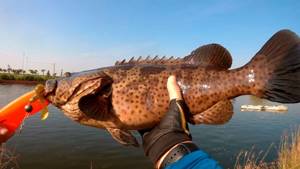
Description
The appearance of these fish is quite varied and attractive; as a rule, various spots, dots, stripes, etc. are located on the dark body. At the same time, they can change their external color, depending on living conditions or mood, depending on the nature of their behavior.
So:
- According to its biological structure, grouper should be classified as a predatory fish species. This is indicated by the massive jaw, while the upper part is somewhat larger in size compared to the lower part.
- The structure of the jaws is such that it allows the grouper to suck in prey with great force. It feeds on small fish, which it constantly hunts for, as well as other living objects that can fit in its mouth.
- The maximum size of some species reaches 2.7 meters and weighs 400-450 kilograms.
- As a rule, large fish are not used for cooking or any dishes. For this purpose, small-sized individuals that have gained weight no more than 50 kilograms are suitable.
- Like most representatives of the underwater world, grouper is not high in calories.
- Grouper meat contains many beneficial components such as vitamins and minerals.
- The largest amount of such substances is found in the meat of this fish: sodium, selenium, phosphorus and calcium, with a calorie content of about 118 kcal per 100 g of meat.
Habitats
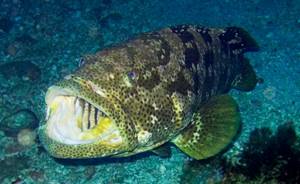
This type of fish prefers tropical waters, so their habitats do not extend to areas where the water is less cold. As a rule, the most suitable habitat for this fish is the waters of the Indian and Pacific oceans.
Grouper is quite often found off the coast of Africa, Japan and Australia. Prefers not deep places, with values no more than 100 meters. He spends a lot of time in hiding and only occasionally, if necessary, does he leave them. Wrecks and coral reefs are common hiding places for grouper. The diet of this predator includes small fish, crabs, lobsters, as well as small sharks and rays. The main thing is that they fit in his mouth.
As a rule, the grouper swallows its prey whole and instantly, due to the special structure of its jaws. While in its shelter, this fish constantly monitors potential prey and, if it suits it, it immediately swallows it. The grouper reproduces with the help of eggs, which it lays in places where corals accumulate. After birth, the fry of this fish find here both food for themselves and shelter from enemies.
Friendly grouper
Interesting facts about grouper
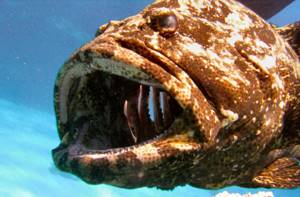
This fish has an interesting appearance: its body is elongated and slightly compressed at the sides. Each individual may differ in individual behavior, therefore, it prefers to stay apart. They form groups only during spawning periods.
Another interesting fact is that the period of puberty is characterized by the fact that all individuals are females, and over time, growing up, they turn into males. In other words, all large individuals are exclusively males.
This fish prefers to stay in a certain territory and does not migrate beyond its borders. At the same time, the grouper very aggressively defends its living space. He shows the same aggressive action towards people if they are near his hiding place. A grouper can easily engage in a fight with a living object that is larger than it in order to protect itself and its home.
If he notices someone who has disturbed his peace, he will leave his shelter and go on the attack, opening his mouth. At the same time, he can bite painfully, swim to the side and, if necessary, will attack again.
Grouper - All about the fish species | Type of fish - Grouper
Social structure and reproduction

Photo: Grouper
Puberty occurs at the age of 2-3 years. Reproduction occurs with the help of eggs. Fish most often deposit it in their chosen shelters. After some time, they fertilize it, and subsequently many fry appear. They are quite viable. Their size and color range are very diverse depending on the subspecies and region of habitat.
Interesting fact: The sea predator is a hermaphrodite. This means that each adult has both an ovary to produce eggs and a gland to produce sperm. In this regard, one individual can produce eggs and fertilize them themselves. All individuals are considered females after birth. However, once they reach sexual maturity, they become males.
It would seem that this is an ideal option for restoring the population size and independent reproduction. However, after several generations, the genome degenerates, so fish of this species need to mix with other species.
The average life expectancy of a representative of this species of marine predator is 30-35 years. Life expectancy directly depends on the species and region of habitat. Giant individuals live in natural conditions for about 70-80 years. Small species that can be bred at home in an aquarium live no more than 10 years.
Grouper soup
Ingredients: three tablespoons of olive oil, two leeks, two onions, two hundred and fifty grams of dry white wine, one sturgeon head, four hundred grams of grouper fillet, parsley, one bay leaf, as well as one clove of garlic, one kilogram of potatoes, one hundred and seventy-five grams of milk, two yolks, salt to taste.
Preparation:
Grouper (fish) is considered very tasty and healthy. We will now look at how to prepare the first dish from it. So, finely chop the leeks, cut the potatoes into large pieces, and finely chop the parsley. Pour olive oil into a pan, add onions and leeks, simmer over low heat for ten minutes until the vegetables acquire a golden hue. Then add one liter of water and bring to a boil. After this, add the fish head and fillet, and ten minutes later add potatoes and salt and continue to cook for another half hour.
After time has passed, the head is removed and the mixture is cooled. Next, the grouper (fish) is taken out of the broth, all bones and skin are removed from it, and then mashed with a fork, put in a blender along with the potatoes and whipped. Add milk to the resulting mixture and mix quickly. Beat the yolk, pour a little broth into it, without ceasing to beat. This mass is put into fish and potato puree, heated but not boiled, and served sprinkled with parsley.
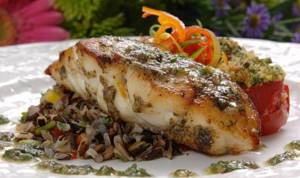
Natural enemies of groupers
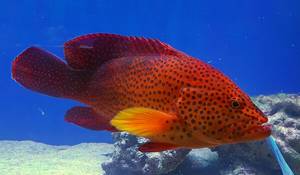
Photo: Giant grouper
Despite its power and fearlessness, the rock bass does not belong to the category of apex predators. Subspecies that are particularly large in size have virtually no enemies. Subspecies, which are characterized by smaller sizes, have quite a lot of enemies in natural habitats.
Natural enemies of fish:
- sharks;
- killer whales;
- moray eels;
- barracudas.
The main enemies of amazing representatives of marine flora and fauna are humans. As a result of his activities, the number of fish has been rapidly declining for almost ten years. This is due to the hunting of them in huge quantities. Poachers caught them not only for the purpose of material gain or as a source of food, but also simply for sport. The caught predator was simply used to make a stuffed animal, which served as a decoration or trophy.
Fish are very sensitive to changes in temperature or other characteristics of the waters of the world's oceans. That is why increasing pollution has a detrimental effect on the population of many representatives of marine flora and fauna.
In what bodies of water is grouper fish found?
The hero of the article prefers warm and salty waters. However, as stated, there are exceptions. Some representatives of the genus live in fresh rivers and lakes. In the waters of Australia, for example, Macculochella lives. In appearance and size it is indistinguishable from an ordinary perch. Of the obvious differences, the coloring catches the eye. McCullochella's is bright.
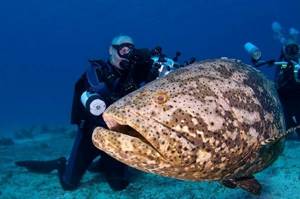
Since the salinity of a reservoir is not a decisive factor in the choice of a place of residence for rock perches, it means that there is another one. This is the bottom landscape. In order to hide on it, the animal needs natural shelters. They are also required by groupers in aquariums.
Small representatives of the genus can be kept at home. In an aquarium, groupers are quite unpretentious if you provide a complex bottom landscape and decent feeding. Otherwise, the pets begin to eat other inhabitants of the artificial reservoir.
It turns out that the hero of the article cannot be found in a river or lagoon lined with sand. We need boulders, coral reefs, polyps, piles of sunken ships and statues, bottom caves and rocks. Also, the reservoir must be deep enough.
Remember that most rock bass are large. Such fish prefer to move away from the surface. Living near the shore is dangerous and inconvenient for them. The standard habitat depth for perch is 15-150 meters.
While sand is tolerated by a few rock perches, many are favorable to silt. You can drown in it, camouflage yourself, no worse than among boulders.
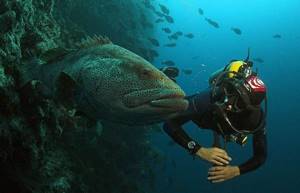
There have been cases when, accidentally getting caught, giant groupers dragged scuba divers into the depths
In a body of water, not only the bottom is important, but also life above the river, lake, and sea. There groupers have allies, for example, pelicans. Birds attack schools of fish, and the heroes of the article eat those who, in fear, strayed from the main mass. At the same time, the main school, seeing the surroundings of perches, is already afraid to scatter, delighting the pelicans. So, rock perch inhabit water bodies with desirable neighbors near them.
The hero of the article also has allies in the water column. In the ocean, for example, interaction with moray eels has been established. The latter resemble snakes and drive fish out of narrow passages and shelters among stones and corals. Groupers look for prey for blind moray eels. The prey is divided simply: whoever swallows it first is lucky.
Among the oceans, groupers are found in the Indian, Pacific and Atlantic. Perch have chosen freshwater reservoirs in Australia, the south and east of Russia, Asia and America. In general, the geography of distribution of species of the family is extensive, although uneven. Most of the groupers are, however, in the Indian Ocean.
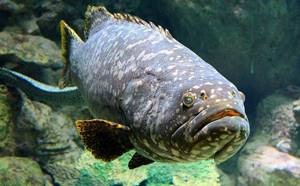
Population and species status
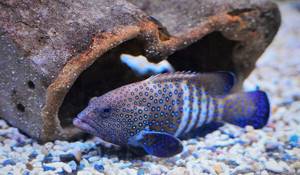
Photo: Grouper in the water
According to the analysis, scientists found that over the past decade, the rock bass population has declined by more than 80%. A number of reasons contribute to this.
Reasons for the decline in fish numbers:
- significant pollution of the world's oceans;
- depletion of flora and fauna, as a result of which the food supply is reduced;
- significant changes in climate and weather conditions.
All these factors together had a significant impact on the number of predators. There has been a decline in population and human activity. This is due to the increase in cost and growing demand for meat from young animals. It has incredibly tender and tasty meat, which has virtually no calories. Also, an important advantage of predator meat is its high content of vitamins and minerals.
Another significant reason for the decline in fish numbers is the huge number of fishermen and poachers who hunt for the desired prey for profit or pleasure. Representatives of this species are especially vulnerable during the breeding season, when they gather at river mouths. During this period, they gather in huge numbers in these places, and the fishermen know it.
Grouper in foil with potatoes
Ingredients: one fish for about seven hundred grams, four potatoes, juice from half a lemon, two tablespoons of vegetable oil, salt and spices to taste.
Preparation:
First of all, the fish is cut, cleaned, removing gills and fins, and washed. Then it is poured with lemon juice and rubbed with salt and spices. This product is left to marinate for half an hour. Meanwhile, peel the potatoes, cut them into slices and place them on foil, which must first be greased with oil. Fish is placed on top of it, and then potatoes again. The foil is wrapped to make a package and placed on a baking sheet, which is then placed in the oven for half an hour.
Baked grouper (fish) is a self-sufficient dish and therefore does not require any additives. If desired, you can serve it with fresh cherry tomatoes or herbs.
